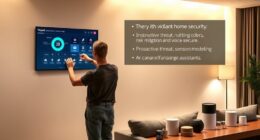Yes, Xfinity does offer home security systems that can be customized to fit your needs. You can choose between professional monitoring or a self-monitoring plan. Their systems integrate with smart devices, allowing you to control everything through the Xfinity app. Installation is flexible too; you can opt for professional help or go the DIY route. Plans start at $10/month for self-protection and go up to $40/month for extensive professional monitoring. With options for video surveillance and enhanced smart home integration, you'll find a package that works for you. You'll discover more about what Xfinity has to offer.
Key Takeaways
- Yes, Xfinity offers customizable home security systems that integrate with smart devices via the Xfinity app.
- They provide 24/7 professional monitoring services through Pro Protection plans starting at $30/month.
- Xfinity Home allows for self-monitoring with a Self Protection plan available at $10/month.
- Installation options include professional installation for about $100 or a DIY approach with no fees.
Overview of Xfinity Home Security
Xfinity Home Security offers customizable systems that seamlessly integrate with smart devices, putting you in control of your home's safety through the convenient Xfinity app. With various home security options, you can tailor your system to meet your specific needs.
Xfinity Home provides professional monitoring services, ensuring your property is protected 24/7. You can choose between Pro Protection and Pro Protection Plus, starting at $30/month and $40/month, respectively, or opt for the Self Protection plan at just $10/month, which allows for self-monitoring.
The installation process is straightforward, as Xfinity Home offers both professional installation for about $100 and user installation for certain devices without additional fees. This flexibility means you can set up your security system according to your comfort level.
Additionally, Xfinity Home features HD video surveillance options, including indoor and outdoor cameras, which can be integrated into your customizable system. With cloud storage available in higher-tier plans, you'll never miss a moment.
Key Features and Benefits

With 24/7 professional monitoring, you'll have peace of mind knowing that your home is constantly supervised and protected from potential threats.
Xfinity Home Security Systems provide real-time alerts and notifications, so you can respond quickly to security breaches. This feature is invaluable for ensuring the safety of your loved ones and property.
The Xfinity Home app enhances your experience by allowing you to control smart home devices like lights, locks, and thermostats from anywhere. Whether you're at home or away, you can manage your security settings seamlessly.
Additionally, Xfinity offers customizable packages to fit your unique security needs and budget. Monitoring plans start as low as $10/month for self-protection, making it accessible for various financial situations. If you prefer professional monitoring, you can opt for plans around $30/month, ensuring expert oversight of your home.
With equipment financing options available, it's easier than ever to invest in your home's security.
Installation Options and Process

Choosing the right installation option for your home security system can enhance your overall experience and guarantee everything is set up properly.
Xfinity Home service offers two primary installation methods: professional installation and DIY installation.
If you prefer a hands-off approach, professional installation is the way to go. An expert will come to your home, conduct a thorough assessment, and provide personalized security solutions tailored to your needs. This option guarantees that your system is properly configured and meets warranty requirements, although it typically costs around $100.
On the other hand, if you're tech-savvy and want to save on installation fees, DIY installation might be your best bet. You can easily set up indoor, outdoor, and doorbell cameras without any additional costs. This option gives you more control over the process, allowing you to customize your system according to your preferences.
Regardless of the installation method you choose, Xfinity provides training after setup to help you get acquainted with your system and its app. This guarantees you're fully equipped to manage your security solutions effectively.
Pricing and Subscription Plans

Exploring the various pricing and subscription plans for home security can help you find the perfect fit for your needs and budget. Here's a quick breakdown of what Xfinity Home offers:
- Self Protection Plan: Starts at just $10/month.
- Pro Protection Plan: Ranges from $30 to $40/month for professional monitoring.
- Pro Protection Plus: $40/month, includes one week of cloud storage for video footage.
- Equipment Costs: Separate from subscription fees, like the Indoor/Outdoor Camera at $5/month for 24 months or a one-time payment of $120.
When it comes to installation, you can choose between professional setup for around $100 or opt for DIY Home Security without any additional charges. This flexibility allows you to manage your upfront equipment costs effectively.
Financing options are also available, making it easier for you to access the security solutions you need. By understanding these pricing and subscription plans, you can choose the best combination of services that fit your lifestyle and budget while ensuring your home stays protected.
Smart Home Integrations

With Xfinity Home, you can easily integrate various smart home devices, enhancing your security system's functionality.
You'll appreciate the convenience of controlling everything through the Xfinity app or with voice commands using the X1 Voice Remote.
This seamless connection not only simplifies your daily routines but also boosts your home's overall security.
Device Compatibility Options
Xfinity Home seamlessly connects with popular smart home brands, enhancing your security and automation experience. This integration allows you to create a thorough smart home ecosystem tailored to your needs.
Here are some key brands you can integrate with the Xfinity Home system:
- Caséta – Smart lighting solutions to control your home's ambiance.
- August – Smart locks for secure and convenient access.
- ecobee – Intelligent thermostats that optimize energy use.
- Chamberlain – Smart garage door openers for added convenience.
With the Xfinity app, you can control all these devices from one place, making home automation easier than ever. You can customize your system to lock doors automatically when armed, merging smart security with everyday tasks.
While the Xfinity Home system offers strong compatibility, it's essential to recognize that it currently lacks support for Alexa and Google Assistant. This limitation may affect your voice control options for some devices.
Nevertheless, Xfinity's robust integrations with these smart home brands still provide a significant enhancement to your home security and convenience.
Voice Control Features
Voice control features in Xfinity Home empower you to manage your security system and smart devices effortlessly using simple voice commands.
With the X1 Voice Remote, you can quickly arm your security system by saying, "Xfinity Home, arm stay," making it convenient to secure your home without fumbling for a smartphone or tablet.
This functionality enhances your security experience by allowing you to lock doors and access live camera feeds directly on your TV.
Plus, the integration with various smart home devices facilitates seamless automation. For instance, you can set your lights to turn off automatically when the security system is armed, simplifying your daily routines.
Xfinity Home supports a wide range of third-party brands, giving you the flexibility to customize your home automation setup.
However, it's crucial to recognize that Xfinity Home doesn't currently support voice control through popular platforms like Alexa or Google Assistant, which may limit some aspects of your smart home integration.
Comparison With Competitors

Comparing Xfinity Home Security Systems to competitors reveals both strengths and weaknesses in pricing, features, and customer satisfaction. Here's a quick look at key factors:
- Pricing: Xfinity's Pro Protection plan starts at $30/month, which is more affordable than ADT's basic plans ($40-$60/month), though ADT includes a free basic security system.
- Equipment Costs: The Xfinity Home Security Plus Plan is priced at $50/month and offers video recording, but it may have higher upfront equipment costs compared to budget-friendly options like SimpliSafe.
- Smart Home Integration: Unlike many competitors, Xfinity doesn't offer integrations with popular voice assistants like Alexa or Google Assistant, limiting your smart home interaction.
- Customer Satisfaction: Xfinity Home's overall security score is 7.3/10, which mightn't meet the expectations set by more established competitors.
While Xfinity offers flexible payment options for equipment, making it more affordable in the long run, the mixed customer satisfaction ratings suggest you should weigh these factors carefully against what competitors provide.
Customer Support and Resources

Customer support for Xfinity Home Security is available 24/7, ensuring you can get help whenever you need it.
Whether you have questions about your system or encounter technical issues, dedicated support is ready to assist you. You can reach out through chat support or access online resources that include FAQs and troubleshooting guides, making it easy to find answers quickly.
Additionally, Xfinity provides community forums where you can engage with other users, sharing experiences and tips related to your home security systems. This collaborative space can enhance your understanding and help you troubleshoot common concerns.
In emergencies, you can rely on the emergency button available on your system's touchscreen. This panic function connects you directly to monitoring personnel, ensuring immediate assistance when you need it most.
Value Assessment and Considerations

Evaluating the value of Xfinity Home Security systems involves considering pricing options, integration with smart home devices, and overall customer satisfaction. Here are some key factors to think about:
- Pricing Flexibility: Monthly plans range from $10 for Self Protection to $55 for Pro Protection Plus.
- Smart Home Integration: These systems work seamlessly with various smart home devices, enhancing your home security and automation experience.
- Professional Monitoring: Ranked #1 in customer satisfaction by J.D. Power, their professional monitoring services offer reliable emergency response.
- Customer Satisfaction Ratings: Xfinity Home boasts an impressive performance score of 9.2/10, although the 7.3/10 customer support score highlights room for improvement.
While the pricing options offer flexibility, be mindful that pre-payments will be credited toward future bills, with no cash refunds available for cancellations.
Frequently Asked Questions
Does Xfinity Provide Security Systems?
Yes, Xfinity provides security systems that you can customize. You can choose between self-monitoring and professional monitoring options, plus enjoy smart home integration and remote access to live video feeds for added convenience and peace of mind. Additionally, Xfinity’s security system offers 24/7 monitoring and alerts for potential security threats. You can also easily control and automate your system through the Xfinity Home app, making it easy to manage your home security on the go. For a more detailed comparison, you can look at the verizon home security overview to see how Xfinity’s offering stacks up against other providers in the market.
How Much Is the Xfinity Security Camera Monthly Fee?
For just $5 a month, you can keep an eye on your home with Xfinity's Indoor or Outdoor Cameras. It's like having a vigilant guardian watching over your space—plus, you can access recorded footage anytime!
Does Xfinity Home Security Include Cameras?
Yes, Xfinity Home Security includes cameras. You can choose from indoor, outdoor, and doorbell options, all offering HD video recording. Plus, you can monitor live feeds remotely through the Xfinity app for added convenience.
What Security Do I Have With Xfinity?
With Xfinity, you've got an impenetrable fortress at your fingertips! You can enjoy 24/7 video monitoring, smart device control, and professional installation, ensuring your home's security is as strong as a superhero's shield.
Conclusion
In today's world, "an ounce of prevention is worth a pound of cure," and Xfinity Home Security offers a solid option for protecting your home.
With its range of features, competitive pricing, and smart home integrations, it's worth considering if you're in the market for a security system.
Take the time to explore your options, weigh the benefits, and find the plan that fits your needs best.
Your peace of mind is just a decision away!









